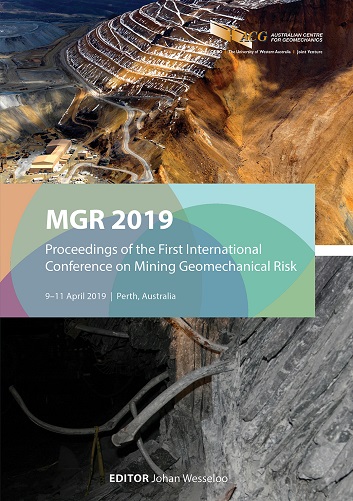Challenges with use of risk matrices for geohazard risk management for resource development projects

|
Authors: Porter, M; Lato, M; Quinn, P; Whittall, J |
DOI https://doi.org/10.36487/ACG_rep/1905_01_Porter
Cite As:
Porter, M, Lato, M, Quinn, P & Whittall, J 2019, 'Challenges with use of risk matrices for geohazard risk management for resource development projects', in J Wesseloo (ed.), MGR 2019: Proceedings of the First International Conference on Mining Geomechanical Risk, Australian Centre for Geomechanics, Perth, pp. 71-84, https://doi.org/10.36487/ACG_rep/1905_01_Porter
Abstract:
Geohazards comprise a subgroup of natural hazards associated with geotechnical, hydrotechnical, tectonic, snow and ice, and geochemical processes that can pose a threat to worker and public safety, asset integrity, and asset management lifecycle cost. Like for most types of threats, the risks from geohazards can be assessed qualitatively or quantitatively and used to inform a geohazard management program. Most mining companies use risk matrices to aid in the assessment, prioritisation, communication and management of corporate risks. These matrices use standardised descriptions of likelihood and consequence to help users assess risks of negative outcomes to health, safety, the environment, assets, and reputation, and are tailored to each organisation’s types of risk exposure and level of risk tolerance. Geohazards and related geotechnical failures can represent low-probability, high-consequence events that plot in the highest risk zones of most corporate risk matrices. Variability in spatial and temporal probabilities for people and infrastructure exposed to geohazards can have a large influence on risk exposure, and this can be challenging to assess and communicate effectively with some risk matrices. Risk is scale-dependent: the business risk due to rockfall from a single slope along a mine access road is vastly different than the total risk due to rockfalls from all slopes along that road, yet guidance is often missing on how the risks from these scenarios should be plotted on a risk matrix. These and other pitfalls associated with use of corporate risk matrices for informed geohazard management are explored.
Keywords: geotechnical, geohazard, risk matrix, risk assessment, risk communication
References:
Bunce, C & Martin, D 2011, ‘Risk estimation for railways exposed to landslides’, Proceedings of the 5th Canadian GeoHazards Conference, Canadian Geotechnical Society, Richmond.
Geotechnical Engineering Office 1998, Landslides and Boulder Falls from Natural Terrain: Interim Risk Guidelines, GEO Report No. 75, Geotechnical Engineering Office, Kowloon.
Hungr, O, Hazzard, J & Evans, SG 1999, ‘Magnitude and frequency of rock falls and rock slides along the main transportation corridors of southwestern British Columbia’, Canadian Geotechnical Journal, vol. 36, pp. 224–238.
Kendall, H, Hubbard, R, Minor, G & Bryan, W 1977, The Risks of Nuclear Power Reactors: A Review of the NRC Reactor Safety Study, WASH-1400, Union of Concerned Scientists, Cambridge.
Mechler, R 2016, ‘Reviewing estimates of the economic efficiency of disaster risk management: opportunities and limitations of using risk-based cost-benefit analysis’, Natural Hazards, vol. 81, issue 3, pp. 2121–2147.
Nishenko, SP & Barton, CC 1995, Scaling Laws for Natural Disaster Fatalities, Open File Report 95-67, US Geological Survey, Reston.
Oboni, F & Oboni, C 2013, What You Need to Know About Risk Management Methods: is it True That PIGs Fly When Evaluating Risks of Projects, Operations and Corporations?, Riskope International, Vancouver.
Porter, M, Jakob, M & Holm, K 2009, ‘Proposed landslide risk tolerance criteria’, Proceedings of the 2009 Canadian Geotechnical Conference, Canadian Geotechnical Society, Richmond.
Porter, M, Jakob, M, Holm, K & McDougall, S 2017 ‘Risk-based landslide safety assessments in Canada’, in JA De Gaff & A Shakoor Proceedings of the 3rd North American Symposium on Landslides, Association of Environmental & Engineering Geologists, Lexington, pp. 574–584.
Porter, M, Leir, M, Baumgard, A & Ferris, G 2014, ‘Integrating terrain and geohazard knowledge into the pipeline lifecycle’, Proceedings of the 6th Canadian GeoHazards Conference, Canadian Geotechnical Society, Richmond.
Thomas, P, Bratvold, RB & Bickel, JE 2014, ‘The risk of using risk matrices’, Society of Petroleum Engineers Economics and Management, vol. 6, no. 2, pp. 56–66.
© Copyright 2025, Australian Centre for Geomechanics (ACG), The University of Western Australia. All rights reserved.
View copyright/legal information
Please direct any queries or error reports to repository-acg@uwa.edu.au
View copyright/legal information
Please direct any queries or error reports to repository-acg@uwa.edu.au
